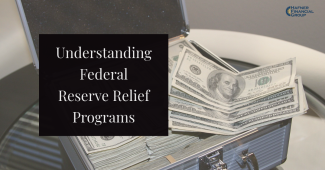
Understanding Federal Reserve Relief Programs
We all know that maintaining and regulating the nation’s economy is the primary job of the Federal Reserve, but what exactly are the ramifications we must face when an economic crisis is imminent? Just like every economic crisis comes in different forms and is caused by a variety of different circumstances so too are the solutions the Federal Reserve comes up with to mitigate possible economically disastrous scenarios. With the recent widespread economic turmoil caused by the Covid-19 pandemic, we witnessed just how quickly the world economy could be brought to its heels in the blink of an eye. Because of the very real possibility of widespread economic devastation on top of a devastating pandemic, it became necessary for the Federal Reserve to step in and provide a stimulus check to nearly every American. Obviously, money never comes without a cost. So what might the long term ramifications of the last round of stimulus checks be and how do they compare with the last solution put forward by the Federal Reserve when the economy was in danger?
The most recent economic disaster to compare with Covid-19 was the 2008 financial crisis and recession. Studying how the Federal Reserve handled this last calamity might shed light on how to navigate the challenges that the latest stimulus checks have caused. Although the causes for these crises were drastically different the Fed’s solution was the same, create new money, what differed was who this newly created money went to and the overall cost it would occur. So what exactly were the long term effects of the 2008 stimulus packages? What were the positives and negatives and how might they compare with the decisions we’ve seen the Fed recently make?
The fear on everyone’s mind whenever the Federal Reserve begins to create more money during an economic crisis is inflation. This is a very rational fear that isn’t helped by the fact that new money only really stops being created when inflation becomes evident. Consequently, newly minted money is only a hopeful solution to what may be a long-term problem. Luckily, the 2008 stimulus packages brought a jolt to the economy and ushered in an 11-year long bull market as stocks began to rise. While this rise in stock value was undoubtedly a massive surprising benefit to investors it was a perfectly rational ramification in hindsight. Since inflation is almost always evident with the creation of so much new money the only solution the Fed can really come up with to limit the problem is to increase taxes. As new taxes or tax increases aren’t on any politician’s talking points, at least not openly the money has to inflate something. The price of goods and the value of the dollar remained relatively constant throughout the last decade despite the fears of some that the stimulus would bring. A rise in the price of bonds led investors to place their money in stocks bringing them up to inflated levels.
The solution to the economic turmoil caused by the most recent pandemic that the Federal Reserve formulated was to give nearly every American a check and bring some much-needed spending to the stagnated economy. The obvious benefit to these checks was that they went to almost every single person and kept the wheels of the market spinning to see another day. Due to widespread unemployment and economic uncertainty, most people spent their money on the goods and services that would keep them going for another day and some are already seeing the rise in food cost. The other solution provided by the Federal Reserve was to keep interest rates as low as possible. This new historic low in borrowing has led many companies to make ambitious expansions and stock prices to rise again after taking a hefty blow. The most recent negative ramification we have witnessed from these record-breaking low-interest rates is the difficulty older Americans are facing on the verge of retirement as some must take on uncertain risks to keep financial security.
Another interesting question looms over us as new stimulus checks are making their way over the horizon. Are these negative ramifications just the beginning of something even more severe? Just how much will necessities like food in toiletries inflate in price and can the market surge indifferently especially in the wake of such uncertain times? Are market forecasters correct in their assumption that an even more economically prosperous time is just around the horizon? Or is it a bubble that is rapidly inflating just waiting to pop and cause an even greater financial downturn? Time will tell but with the new vaccination underway there may be light on the other side for both life and the economy to resume back to normal.
*This content is developed from sources believed to be providing accurate information. The information provided is not written or intended as tax or legal advice and may not be relied on for purposes of avoiding any Federal tax penalties. Individuals are encouraged to seek advice from their own tax or legal counsel. Individuals involved in the estate planning process should work with an estate planning team, including their own personal legal or tax counsel. Neither the information presented nor any opinion expressed constitutes a representation by us of a specific investment or the purchase or sale of any securities. Asset allocation and diversification do not ensure a profit or protect against loss in declining markets. This material was developed and produced by Advisor Websites to provide information on a topic that may be of interest. Copyright 2025 Advisor Websites.

